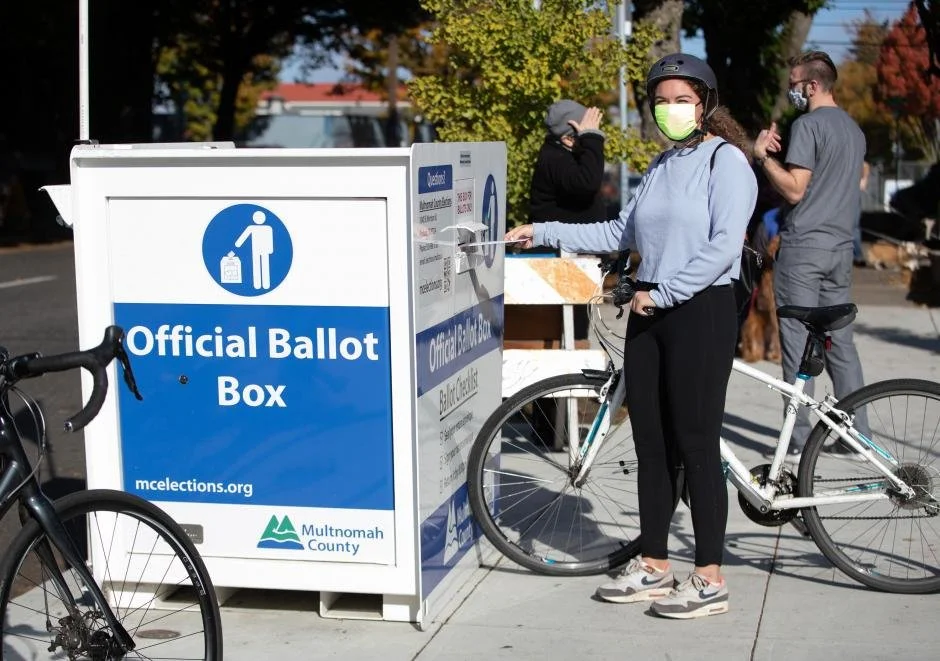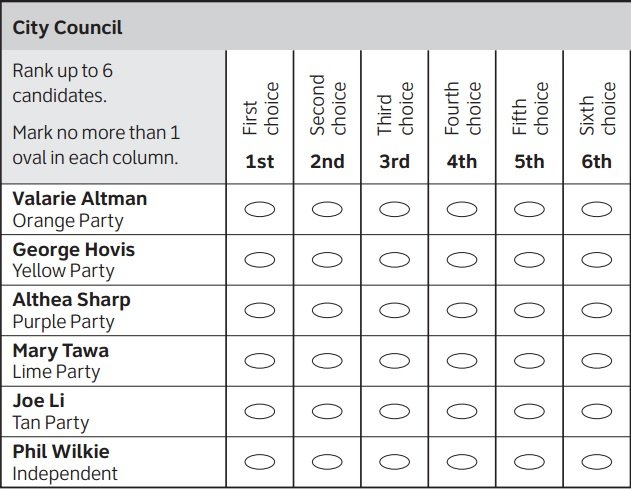Multnomah County Charter Amendment
YES on Measure 26-232 :: Ranked Choice Voting
Ranked Choice Voting: Giving Voters More Choice and More Power
Sample ranked choice voting ballot, FairVote
This November, Multnomah County voters will vote on Measure 26-232 to decide whether to allow voters to rank candidates in order of preference, otherwise known as ranked choice voting (RCV).
Under our current “winner-take-all” election system, politicians often win elections with less than 50% of the vote, new voices and candidates are shut out from running, and voters’ choices are limited by forcing us to vote for the “lesser of two evils.”
RCV is a simple, fair, and easy way to help fix these problems by giving voters more power and choice.
What does Measure 26-232 do?
This ballot measure would mean voters can rank candidates in order of preference. It would only apply to Multnomah County elections for public office, including the County Chair, Commissioners, District Attorney, Auditor, and Sheriff.
The specific type of ranked choice voting is known as “instant runoff ranked choice voting.” This allows voters to decide who should take office in one election, while producing more representative results than our current runoff system. General elections (in November) have higher turnout that better represents the community, including voters of color and younger voters.
Why should we adopt ranked choice voting?
With RCV, Multnomah County voters get:
More Voices. Young or old, renter or homeowner, Black, white, or brown, every voter in Multnomah County has the right to vote for leaders who represent our communities. RCV tends to attract more diverse candidates, giving voters more opportunity to cast a vote for someone who represents their community.
More Choices. By ranking candidates, voters no longer have to worry about wasted votes or feeling pressure to choose between a candidate you like and a candidate that “can win.” RCV reduces barriers to new candidates and brings new voices by allowing people to run without being “spoilers.” This means voters have more meaningful choices and more reasons to vote.
Better Representation. Every voter’s voice matters. RCV elects candidates that represent the whole county, and not just a few powerful neighborhoods.
Positive, Issue-Driven Campaigns. Voters want to support candidates who align with their values. RCV reduces incentives for candidates to attack their opponents and instead focus on civil, issue-oriented platforms that more fully represent the views and experiences of their constituents.
How does ranked choice voting work?
RCV lets people rank candidates in the order they prefer. To win, a candidate must receive more than 50% of the vote. If no candidate gets 50%, an “instant runoff” occurs where the ballots for the last-place candidate are instantly recounted for the voters’ second choice.
By giving voters the power to rank candidates in order of preference, RCV ensures that the most favored candidate always wins — either by winning with a simple first-choice majority, or by winning with the greatest number of votes for first-choice, second-choice, third-choice and so on.
Voters can still vote for a single candidate as they do now, but RCV gives voters the option to rank candidates – so if your favorite candidate doesn’t win, your vote counts for their next choice instead. Learn more about RCV or watch this explainer video.
Where else is RCV used?
RCV has been successful in Benton County, Oregon and in dozens of counties and cities ranging from small-town Utah to New York City. In a recent ranked choice election, Democrat Mary Peltola made history as the first-ever Alaska Native in Congress (learn more about the election results).
Explore all the places in the United States where RCV is currently being used.
What does the ballot measure language say?
Measure 26-232 is a ballot measure to amend the Multnomah County charter. The question reads, “Should elections for county offices give voters option of ranking candidates in preferred order, with instant-runoff vote counting process determining results?” See full information here.
Who supports this measure?
The following organizations support the amendment for ranked choice voting in Multnomah County:
ACLU of Oregon
APANO (Asian Pacific American Network of Oregon)
Basic Rights Oregon
Cascades AIDS Project
Coalition of Communities of Color
Latino Network
League of Women Voters of Portland
Next Up
North Star Action Center
Oregon Ranked Choice Voting
Unite Oregon
Urban League
Who is opposed?
There is no formally organized opposition to this measure.
What is the Multnomah County Charter Committee and how did we get here?
The Multnomah County Charter Committee is composed of 17 volunteers and convenes every six years to review the county charter (equivalent to the county’s constitution) and make recommendations for changes to be referred to voters. After extensive research and community engagement, the committee voted unanimously to recommend expanding voting rights to noncitizens. It was officially recommended on July 5; later that month, the Multnomah County Board of Commissioners then voted to refer these measures to county voters. Learn more about the committee and its work in its final report here.
Is this the same as STAR Voting?
No, ranked choice voting is a tested and extensively researched system. Alternative methods of voting such as STAR Voting, have not been implemented in any election across the nation, thus it’s not known how it would perform in improving equitable outcomes of elections, or how voters, especially communities of color, will behave with it.
While no electoral system is perfect, ranked choice voting is a simple, highly proven method to give voters more choices, is complementary to future democracy reforms (e.g. expansion of voter registration, proportional representation, etc.), and elects more diverse candidates.


